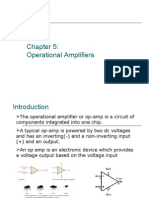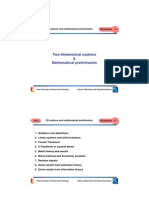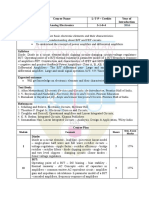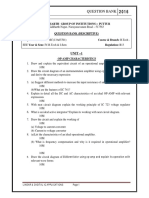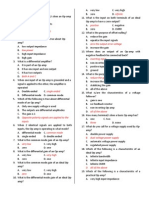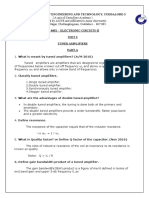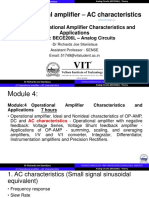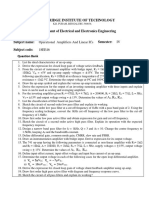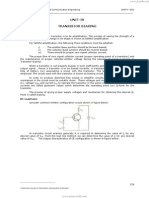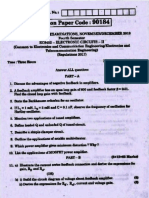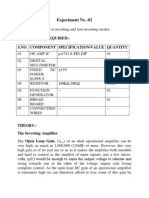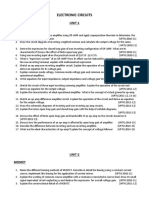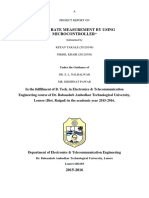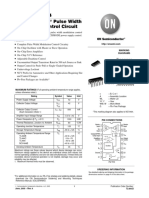0 ratings0% found this document useful (0 votes)
295 views151 pagesInverting and Non-Inverting Amplifier
Uploaded by
bass plusCopyright
© © All Rights Reserved
We take content rights seriously. If you suspect this is your content, claim it here.
Available Formats
Download as PDF, TXT or read online on Scribd
0 ratings0% found this document useful (0 votes)
295 views151 pagesInverting and Non-Inverting Amplifier
Uploaded by
bass plusCopyright
© © All Rights Reserved
We take content rights seriously. If you suspect this is your content, claim it here.
Available Formats
Download as PDF, TXT or read online on Scribd
You are on page 1/ 151
Inverting amplifier
Inverting Operational Amplifier
• The Inverting Operational Amplifier configuration is one of
the simplest and most commonly used op-amp topologies
• The inverting operational amplifier is basically a constant or
fixed-gain amplifier producing a negative output voltage as
its gain is always negative.
• We saw in the last tutorial that the Open Loop Gain, ( AVO )
of an operational amplifier can be very high, as much as
1,000,000 (120dB) or more.
• However, this very high gain is of no real use to us as it
makes the amplifier both unstable and hard to control as
the smallest of input signals, just a few micro-volts, (μV)
would be enough to cause the output voltage to saturate
and swing towards one or the other of the voltage supply
rails losing complete control of the output.
Inverting Operational Amplifier
• As the open loop DC gain of an operational amplifier is
extremely high we can therefore afford to lose some of this
high gain by connecting a suitable resistor across the
amplifier from the output terminal back to the inverting
input terminal to both reduce and control the overall gain
of the amplifier.
• This then produces and effect known commonly as
Negative Feedback, and thus produces a very stable
Operational Amplifier based system.
• Negative Feedback is the process of “feeding back” a
fraction of the output signal back to the input, but to make
the feedback negative, we must feed it back to the negative
or “inverting input” terminal of the op-amp using an
external Feedback Resistor called Rƒ.
• This feedback connection between the output and the
inverting input terminal forces the differential input voltage
towards zero.
Inverting Operational Amplifier
• This effect produces a closed loop circuit to the amplifier resulting in the
gain of the amplifier now being called its Closed-loop Gain.
• Then a closed-loop inverting amplifier uses negative feedback to
accurately control the overall gain of the amplifier, but at a cost in the
reduction of the amplifiers gain.
• This negative feedback results in the inverting input terminal having a
different signal on it than the actual input voltage as it will be the sum of
the input voltage plus the negative feedback voltage giving it the label or
term of a Summing Point.
• We must therefore separate the real input signal from the inverting input
by using an Input Resistor, Rin.
• As we are not using the positive non-inverting input this is connected to a
common ground or zero voltage terminal as shown below, but the effect
of this closed loop feedback circuit results in the voltage potential at the
inverting input being equal to that at the non-inverting input producing
a Virtual Earth summing point because it will be at the same potential as
the grounded reference input.
• In other words, the op-amp becomes a “differential amplifier”.
Inverting Operational Amplifier
Configuration
Inverting Amplifier Working
• In this Inverting Amplifier circuit the operational amplifier is
connected with feedback to produce a closed loop operation.
• When dealing with operational amplifiers there are two very
important rules to remember about inverting amplifiers, these are:
“No current flows into the input terminal” and that “V1 always
equals V2”.
• However, in real world op-amp circuits both of these rules are
slightly broken.
• This is because the junction of the input and feedback signal ( X ) is
at the same potential as the positive ( + ) input which is at zero volts
or ground then, the junction is a “Virtual Earth”.
• Because of this virtual earth node the input resistance of the
amplifier is equal to the value of the input resistor, Rin and the
closed loop gain of the inverting amplifier can be set by the ratio of
the two external resistors.
Working (Cont.)
• We said above that there are two very important rules to
remember about Inverting Amplifiers or any operational amplifier
for that matter and these are.
• No Current Flows into the Input Terminals
• The Differential Input Voltage is Zero as V1 = V2 = 0 (Virtual Earth)
• Then by using these two rules we can derive the equation for
calculating the closed-loop gain of an inverting amplifier, using first
principles.
• Current ( i ) flows through the resistor network as shown.
Expression
Expression-2
Expression-3
• The negative sign in the equation indicates an inversion
of the output signal with respect to the input as it is
180o out of phase.
• This is due to the feedback being negative in value.
• The equation for the output voltage Vout also shows
that the circuit is linear in nature for a fixed amplifier
gain as Vout = Vin x Gain.
• This property can be very useful for converting a
smaller sensor signal to a much larger voltage.
Non-inverting Operational Amplifier
Non-inverting Operational Amplifier
• The second basic configuration of an operational
amplifier circuit is that of a Non-inverting Operational
Amplifier design.
• In non-inverting operational amplifier configuration,
the input voltage signal, ( VIN ) is applied directly to the
non-inverting ( + ) input terminal which means that the
output gain of the amplifier becomes “Positive” in
value in contrast to the “Inverting Amplifier” circuit we
saw in the last tutorial whose output gain is negative in
value.
• The result of this is that the output signal is “in-phase”
with the input signal.
Amplifier Design
• Feedback control of the non-inverting operational
amplifier is achieved by applying a small part of
the output voltage signal back to the inverting (–)
input terminal via a Rƒ – R2 voltage divider
network, again producing negative feedback.
• This closed-loop configuration produces a non-
inverting amplifier circuit with very good stability,
a very high input impedance, Rin approaching
infinity, as no current flows into the positive input
terminal, (ideal conditions) and a low output
impedance, Rout as shown below.
Non-inverting Operational Amplifier
Configuration
Amplifier Configuration Explanation
• In the previous Inverting Amplifier tutorial, we said
that for an ideal op-amp “No current flows into the
input terminal” of the amplifier and that “V1 always
equals V2”.
• This was because the junction of the input and
feedback signal ( V1 ) are at the same potential.
• In other words the junction is a “virtual earth”
summing point. Because of this virtual earth node the
resistors, Rƒ and R2 form a simple potential divider
network across the non-inverting amplifier with the
voltage gain of the circuit being determined by the
ratios of R2 and Rƒ as shown below.
Non-inverting Operational Amplifier
Gain
Explanation
• We can see from the equation above, that the overall
closed-loop gain of a non-inverting amplifier will always be
greater but never less than one (unity), it is positive in
nature and is determined by the ratio of the values
of Rƒ and R2.
• If the value of the feedback resistor Rƒ is zero, the gain of
the amplifier will be exactly equal to one (unity). If
resistor R2 is zero the gain will approach infinity, but in
practice it will be limited to the operational amplifiers
open-loop differential gain, ( AO ).
• We can easily convert an inverting operational amplifier
configuration into a non-inverting amplifier configuration
by simply changing the input connections as shown.
Non-inverting amplifier
Thanks
LINEAR APPLICATIONS
OF OP-AMP
• The Differential Amplifier
• Integrator
• Active filter
• Voltage regulator
The Differential Amplifier-1
• The differential amplifier amplifies the voltage difference
present on its inverting and non-inverting inputs
• The differential amplifier is a voltage subtractor circuit
which produces an output voltage proportional to the
voltage difference of two input signals applied to the
inputs of the inverting and non-inverting terminals of an
operational amplifier.
• As a standard operational amplifier has two inputs,
inverting and no-inverting, we can connect signals to both
of these inputs at the same time producing another
common type of operational amplifier circuit called
a Differential Amplifier.
The Differential Amplifier-2
• But by connecting one voltage signal onto one input
terminal and another voltage signal onto the other input
terminal the resultant output voltage will be proportional to
the “Difference” between the two input voltage signals
of V1 and V2.
• Then differential amplifiers amplify the difference between
two voltages making this type of operational amplifier
circuit a Subtractor unlike a summing amplifier which
adds or sums together the input voltages.
Differential Amplifier circuit
The Transfer Function
Differential Amplifier Equation
• If all the resistors are all of the same ohmic value, that is: R1 =
R2 = R3 = R4 then the circuit will become a Unity Gain
Differential Amplifier and the voltage gain of the amplifier will
be exactly one or unity.
• Then the output expression would simply be Vout = V2 – V1.
• Also note that if input V1 is higher than input V2 the output
voltage sum will be negative, and if V2 is higher than V1, the
output voltage sum will be positive.
• The Differential Amplifier circuit is a very useful op-amp
circuit and by adding more resistors in parallel with the input
resistors R1 and R3, the resultant circuit can be made to either
“Add” or “Subtract” the voltages applied to their respective
inputs.
Instrumentation Amplifier
Instrumentation Amplifier
• Instrumentation Amplifiers (in-amps) are very high gain differential
amplifiers which have a high input impedance and a single ended
output. Instrumentation amplifiers are mainly used to amplify very
small differential signals from strain gauges, thermocouples or current
sensing devices in motor control systems.
• Unlike standard operational amplifiers in which their closed-loop gain
is determined by an external resistive feedback connected between
their output terminal and one input terminal, either positive or
negative, “instrumentation amplifiers” have an internal feedback
resistor that is effectively isolated from its input terminals as the input
signal is applied across two differential inputs, V1 and V2.
• The instrumentation amplifier also has a very good common mode
rejection ratio, CMRR (zero output when V1 = V2) well in excess of
100dB at DC.
• A typical example of a three op-amp instrumentation amplifier with a
high input impedance ( Zin ) is given below:
High Input Impedance Instrumentation
Amplifier
Explanation
• The two non-inverting amplifiers form a differential input stage
acting as buffer amplifiers with a gain of 1 + 2R2/R1 for
differential input signals and unity gain for common mode input
signals.
• Since amplifiers A1 and A2 are closed loop negative feedback
amplifiers, we can expect the voltage at Va to be equal to the
input voltage V1. Likewise, the voltage at Vb to be equal to the
value at V2.
• As the op-amps take no current at their input terminals (virtual
earth), the same current must flow through the three resistor
network of R2, R1 and R2 connected across the op-amp
outputs.
• This means then that the voltage on the upper end of R1 will be
equal to V1 and the voltage at the lower end of R1 to be equal
to V2.
Explanation
• This produces a voltage drop across resistor R1 which is equal
to the voltage difference between inputs V1 and V2, the
differential input voltage, because the voltage at the summing
junction of each amplifier, Va and Vb is equal to the voltage
applied to its positive inputs.
• However, if a common-mode voltage is applied to the amplifiers
inputs, the voltages on each side of R1 will be equal, and no
current will flow through this resistor.
• Since no current flows through R1 (nor, therefore, through
both R2 resistors, amplifiers A1 and A2 will operate as unity-
gain followers (buffers).
• Since the input voltage at the outputs of
amplifiers A1 and A2 appears differentially across the three
resistor network, the differential gain of the circuit can be varied
by just changing the value of R1.
Instrumentation Amplifier Equation
• The voltage output from the differential op-amp A3 acting as a
subtractor, is simply the difference between its two inputs
( V2 – V1 ) and which is amplified by the gain of A3 which may
be one, unity, (assuming that R3 = R4).
• Then we have a general expression for overall voltage gain of
the instrumentation amplifier circuit as:
The Integrator Amplifier
The Integrator Amplifier-1
• The integrator Op-amp produces an output voltage that is
both proportional to the amplitude and duration of the
input signal
• The ideal op-amp integrator is an inverting amplifier
whose output voltage is proportional to the negative
integral of the input voltage thereby simulating
mathematical integration.
• Operational amplifiers can be used as part of a positive or
negative feedback amplifier or as an adder or subtractor
type circuit using just pure resistances in both the input
and the feedback loop.
The Integrator Amplifier-2
• But what if we where to change the purely resistive ( Rƒ )
feedback element of an inverting amplifier with a
frequency dependant complex element that has a
reactance, ( X ), such as a Capacitor, C. What would be
the effect on the op-amps voltage gain transfer function
over its frequency range as a result of this complex
impedance.
• By replacing this feedback resistance with a capacitor we
now have an RC Network connected across the
operational amplifiers feedback path producing another
type of operational amplifier circuit commonly called
an Op-amp Integrator circuit as shown below.
Op-amp Integrator Circuit
Op-amp Integrator-1
• As its name implies, the Op-amp Integrator is an operational
amplifier circuit that performs the mathematical operation
of Integration, that is we can cause the output to respond to
changes in the input voltage over time as the op-amp integrator
produces an output voltage which is proportional to the integral
of the input voltage.
• In other words the magnitude of the output signal is determined
by the length of time a voltage is present at its input as the
current through the feedback loop charges or discharges the
capacitor as the required negative feedback occurs through the
capacitor.
• When a step voltage, Vin is firstly applied to the input of an
integrating amplifier, the uncharged capacitor C has very little
resistance and acts a bit like a short circuit allowing maximum
current to flow via the input resistor, Rin as potential difference
exists between the two plates.
Op-amp Integrator-2
• No current flows into the amplifiers input and point X is a
virtual earth resulting in zero output.
• As the impedance of the capacitor at this point is very low,
the gain ratio of XC/RIN is also very small giving an overall
voltage gain of less than one, ( voltage follower circuit ).
• As the feedback capacitor, C begins to charge up due to
the influence of the input voltage, its impedance Xc slowly
increase in proportion to its rate of charge.
• The capacitor charges up at a rate determined by the RC
time constant, ( τ ) of the series RC network.
• Negative feedback forces the op-amp to produce an
output voltage that maintains a virtual earth at the op-
amp’s inverting input.
Op-amp Integrator-3
• Since the capacitor is connected between the op-amp’s
inverting input (which is at virtual ground potential) and
the op-amp’s output (which is now negative), the potential
voltage, Vc developed across the capacitor slowly
increases causing the charging current to decrease as the
impedance of the capacitor increases.
• This results in the ratio of Xc/Rin increasing producing a
linearly increasing ramp output voltage that continues to
increase until the capacitor is fully charged.
• At this point the capacitor acts as an open circuit, blocking
any more flow of DC current. The ratio of feedback
capacitor to input resistor ( XC/RIN ) is now infinite
resulting in infinite gain.
Waveform
• The result of this high gain (similar to the op-amps open-
loop gain), is that the output of the amplifier goes into
saturation as shown below.
• (Saturation occurs when the output voltage of the
amplifier swings heavily to one voltage supply rail or the
other with little or no control in between).
Waveform-2
• The rate at which the output voltage increases (the rate of
change) is determined by the value of the resistor and the
capacitor, “RC time constant“.
• By changing this RC time constant value, either by
changing the value of the Capacitor, C or the Resistor, R,
the time in which it takes the output voltage to reach
saturation can also be changed for example.
Ramp Generator
• If we apply a constantly changing input signal such as a square
wave to the input of an Integrator Amplifier then the capacitor
will charge and discharge in response to changes in the input
signal.
• This results in the output signal being that of a sawtooth
waveform whose output is affected by the RC time constant of
the resistor/capacitor combination because at higher
frequencies, the capacitor has less time to fully charge.
• This type of circuit is also known as a Ramp Generator and
the transfer function is given below.
Transfer Function
• Thus the circuit has the transfer function of an inverting
integrator with the gain constant of -1/RC.
• The minus sign ( – ) indicates a 180o phase shift because
the input signal is connected directly to the inverting input
terminal of the operational amplifier.
Active Filters
Active Filters
• Filters are electronic circuits that allow certain frequency
components and / or reject some other.
• They are passive and are the electric circuits or networks that
consist of passive elements like resistor, capacitor, and (or) an
inductor.
Types of Active Filters
• Active filters are the electronic circuits, which consist of active
element like op-amp(s) along with passive elements like
resistor(s) and capacitor(s).
• Active filters are mainly classified into the following four
types based on the band of frequencies that they are allowing
and / or rejecting −
• Active Low Pass Filter
• Active High Pass Filter
• Active Band Pass Filter
• Active Band Stop Filter
Frequency Response
Frequency Response
Active Low Pass Filter
• If an active filter allows (passes) only low
frequency components and rejects (blocks) all other high
frequency components, then it is called as an active low
pass filter.
• The circuit diagram of an active low pass filter is shown
in the following figure −
Explanation
• We know that the electric network, which is connected to the
non-inverting terminal of an op-amp is a passive low pass
filter.
• So, the input of a non-inverting terminal of an opamp is the
output of a passive low pass filter.
• Observe that the above circuit resembles a non-inverting
amplifier. It is having the output of a passive low pass filter as
an input to the non-inverting terminal of op-amp.
• Hence, it produces an output, which is (1+Rf/R1) times the
input present at the non-inverting terminal.
• We can choose the values of Rf and R1 suitably in order to
obtain the desired gain at the output. Suppose, if we consider
the resistance values of Rf and R1 as zero ohms and infinity
ohms, then the above circuit will produce a unity gain low pass
filter output.
Active High Pass Filter
• If an active filter allows (passes) only high
frequency components and rejects (blocks) all other low
frequency components, then it is called an active high
pass filter.
• The circuit diagram of an active high pass filter is shown
in the following figure −
Explanation
• We know that the electric network, which is connected to the
non-inverting terminal of an op-amp is a passive high pass
filter.
• So, the input of a non-inverting terminal of opamp is the output
of passive high pass filter.
• Now, the above circuit resembles a non-inverting amplifier.
• It is having the output of a passive high pass filter as an input
to non-inverting terminal of op-amp.
• Hence, it produces an output, which is (1+Rf/R1) times the
input present at its non-inverting terminal.
• We can choose the values of Rf and R1 suitably in order to
obtain the desired gain at the output. Suppose, if we consider
the resistance values of Rf and R1 as zero ohms and infinity
ohms, then the above circuit will produce a unity gain high
pass filter output.
Active Band Pass Filter
• If an active filter allows
(passes) only one band of
frequencies, then it is
called as an active band
pass filter. In general,
this frequency band lies
between low frequency
range and high frequency
range.
• So, active band pass filter
rejects (blocks) both low
and high frequency
components.
• The circuit diagram of an
active band pass filter is
shown in the following
figure
•
Explanation-1
• Observe that there are two parts in the circuit diagram of
active band pass filter: The first part is an active high pass
filter, while the second part is an active low pass filter.
• The output of the active high pass filter is applied as an
input of the active low pass filter.
• That means, both active high pass filter and active low
pass filter are cascaded in order to obtain the output in
such a way that it contains only a particular band of
frequencies.
• The active high pass filter, which is present at the first
stage allows the frequencies that are greater than
the lower cut-off frequency of the active band pass filter.
Explanation-2
• So, we have to choose the values of RB and CB suitably,
to obtain the desired lower cut-off frequency of the
active band pass filter.
• Similarly, the active low pass filter, which is present at
the second stage allows the frequencies that are smaller
than the higher cut-off frequency of the active band pass
filter.
• So, we have to choose the values of RA and CA suitably
in order to obtain the desired higher cut-off frequency of
the active band pass filter.
• Hence, the circuit in the diagram discussed above will
produce an active band pass filter output.
Active Band Stop Filter
• If an active filter rejects (blocks) a particular band of
frequencies, then it is called as an active band stop filter.
• In general, this frequency band lies between low frequency
range and high frequency range.
• So, active band stop filter allows (passes) both low and high
frequency components.
• The block diagram of an active band stop filter is shown in the
following figure −
Explanation
• Observe that the block diagram of an active band stop filter
consists of two blocks in its first stage: an active low pass filter
and an active high pass filter.
• The outputs of these two blocks are applied as inputs to the
block that is present in the second stage.
• So, the summing amplifier produces an output, which is the
amplified version of sum of the outputs of the active low pass
filter and the active high pass filter.
• Therefore, the output of the above block diagram will be
the output of an active band stop , when we choose the cut-
off frequency of low pass filter to be smaller than cut-off
frequency of a high pass filter.
• The circuit diagram of an active band stop filter is shown in
the following figure
Circuit Diagram
Explanation
• We have already seen the circuit diagrams of an active
low pass filter, an active high pass filter and a summing
amplifier.
• Observe that we got the above circuit diagram of active
band stop filter by replacing the blocks with the respective
circuit diagrams in the block diagram of an active band
stop filter.
Voltage regulator using operational
amplifier.
Introduction
• A voltage regulator is an integrated circuit (IC) that
provides a constant fixed output voltage regardless of a
change in the load or input voltage.
• A linear voltage regulator works by automatically adjusting
the resistance via a feedback loop, accounting for
changes in both load and input, all while keeping the
output voltage constant.
• Electronic voltage regulators utilize solid-state
semiconductor devices to smooth out variations in the
flow of current.
• In most cases, they operate as variable resistances that
is, resistance decreases when the electrical load is heavy
and increases when the load is lighter.
Introduction-2
• A voltage regulator circuit using an op amp, emitter follower
transistor and Zener diode. These types of circuits provide
better load regulation than a simple Zener diode and resistor
alone.
• In addition, if you make R1 a variable resistor, then the output
voltage could be varied for a large range of voltages.
• For this op amp circuit, we use the operational amplifier as a
comparator and the two voltage levels that we are comparing
are the regulated input reference, and final output.
• We should also remember that we use potential dividers (PD)
to get a sample of the input and output voltages.
• As you can see, the input side consists of a Zener diode and
resistor, and this arrangement is the same if you were to have
a simple Zener diode regulator circuit.
Introduction-3
• The regulated output from the Zener diode and resistor
network feeds the non-inverting input of the op amp.
• Engineers usually call this a reference voltage because it
remains the same, even when the input voltage varies.
• The Zener diode obviously determines this fixed reference
voltage across it, which we call VZ.
• The output voltage from the second PD consisting of R1
and R2 feeds the inverting input of the comparator.
• This voltage is V2, which we usually find using the simple
PD formula.
Circuit Diagram
Expression
• The two input voltages subtract as (VZ – V2), and the result
value is the output VO from the op amp that drives a power
transistor in emitter-follower configuration.
• VO = A × (VZ – V2)
• In this formula, A is the open loop gain of the operational
amplifier, which is usually 100000 for a 741-type device.
• The final output voltage VOUT is (VO – 0.7V).
• As you can see, it is always 0.7V less because of the emitter-
follower junctions.
• Let us say that the output voltage VOUT begins to fall because
of the loading across it.
• Then V2 across R2 also falls, and then the result of (VZ – V2)
increases, and VO also increases, making the transistor
conduct more, thereby increasing the output voltage.
• As you can see, the mechanism of this comparator circuit is
such that it tries to make V2 approximately equal to VZ all the
time.
Expression
• V2 = Vout x R2/(R1+R2).
• Here is a simple PD formula showing V2 in terms of R1
and R2.
• V2 = VZ ,Since, the op amp tries to make V2 and VZ the
same by compensating the output.
• we can write the following expression.
• VZ = Vout x R2/(R1+R2)By substitution, we derive this
expression for VZ.
• VZ x (R1 + R2) = Vout x R2 (Here, we rearrange for Vout.)
• Vout = VZ x (R1+R2)/R2
= VZ x (R1/R2 + R2/R2)
Vout = VZ x (R1/R2 + 1)
Advantages Of Voltage Regulator
• It is very simple to implement and easy to use.
• It gives low output ripple voltage.
• It has a fast response time to load.
• It has less noise and low electromagnetic interference.
• It is more cost-efficient.
Disadvantages Of Voltage Regulator
• Its efficiency of it is relatively low.
• It gives the output voltage always less than the input
voltage i.e., it performs only step down operation.
• It requires a heat sink since it dissipates excess power as
heat and becomes extremely hot during regulation.
• It requires large spaces.
Applications Of Voltage Regulator
• One of the most common examples is the mobile charger. The
adapter is supplied with an AC signal. However, the output
voltage signal is a regulated DC signal.
• Every power supply in the world uses a voltage regulator to
provide the desired output voltage. Computers, televisions,
laptops, and all sorts of devices are powered using this
concept.
• Small electronic circuits rely on regulators to operate. Even the
slightest fluctuation in voltage signal can damage the
components of a circuit such as ICs.
• When it comes to power generation systems, voltage
regulators play an essential part in their operation. A solar
power plant generates electricity based on the intensity of
sunlight. It needs a regulator to ensure a regulated constant
output signal.
Thanks
Analog Electronic PID
Controllers
• Proportional Controller Circuit
• Derivative Controller Circuit
• Integral Controller Circuit
• PID Controller Circuit
• Lead-Lag Compensation
Operational Amplifier (Op Amp) PID
Controllers
• Most analog electronic PID controllers utilize
operational amplifiers in their designs.
• It is relatively easy to construct circuits
performing amplification (gain), integration,
differentiation, summation, and other useful
control functions with just a few op-amps,
resistors, and capacitors.
• Mathematical operations such as subtraction,
multiplication by a constant, and addition are
quite easy to perform using analog electronic
(operational amplifier) circuitry.
Formula: proportional-only control
algorithm
Proportional Controller Circuit
• Prior to the advent of reliable digital electronics for
industrial applications, it was natural to use analog
electronic circuitry to perform proportional control for
process control loops.
• For example, the subtraction function necessary to
calculate error (e) from process variable and set point
signals may be performed with a three-amplifier
“subtractor” circuit.
• This particular subtractor circuit calculates error for a
reverse-acting controller.
• As the PV signal increases, the error signal decreases
(becomes more negative).
• It could be modified for direct action simply by swapping
the two inputs: SP on top and PV on bottom such that the
Output becomes PV − SP.
Three-amplifier SubtractorCircuit
Op Amp Proportional Controller Gain
• Gain is really nothing more than multiplication by a
constant, in this case the constant being Kp. A very
simple one-amplifier analog circuit for performing this
multiplication is the inverting amplifier circuit:
• With the potentiometer’s wiper in mid-position, the
voltage gain of this circuit will be 1 (with an inverted
polarity which we shall ignore for now).
• Moving the wiper toward the left-hand side of the
potentiometer increases the circuit’s gain past unity,
while moving the wiper toward the right-hand side of
the potentiometer decreases the gain toward zero.
Op Amp Proportional Controller Gain
Inverting summing circuit
• In order to add the bias (b) term in the
proportional control equation, we need an analog
circuit capable of summing two voltage signals.
• This need is nicely met in the inverting
summing circuit, shown here:
• Combining all these analog functions together
into one circuit, and adding a few extra features
such as direct/reverse action selection, bias
adjustment, and manual control with a null
voltmeter to facilitate bumpless mode transfer,
gives us this complete analog electronic
proportional controller:
Inverting Summing Circuit
Analog electronic Proportional
Controller
Derivative Controller Circuit
• Differentiating and integrating live voltage
signals with respect to time is quite simple
using operational amplifier circuits.
• Instead of using all resistors in the negative
feedback network, we may implement these
calculus functions by using a combination
of capacitors and resistors, exploiting the
capacitor’s natural derivative relationship
between voltage and current.
Equation
Differentiator circuit
• If we build an operational amplifier with a resistor providing
negative feedback current through a capacitor, we create
a differentiator circuit where the output voltage is proportional to
the rate-of-change of the input voltage:
• Since the inverting input of the operational amplifier is held to
ground potential by feedback (a “virtual ground”), the capacitor
experiences the full input voltage of signal A.
• So, as A varies over time, the current through that capacitor will
directly represent the signal A’s rate of change over time
• This current passes through the feedback resistor, creating a voltage
drop at the output of the amplifier directly proportional to
signal A’s rate of change over time.
• Thus, the output voltage of this circuit reflects the input voltage’s
instantaneous rate of change, albeit with an inverted polarity. The
mathematical term RC is the time constant of this circuit.
• For a differentiator circuit such as this, we typically symbolize its
time constant as (the “derivative” time constant).
Circuit Diagram
Integral Controller Circuit
• If we simply swap the locations of the resistor and
capacitor in the feedback network of this operational
amplifier circuit, we create an integrator circuit where
the output voltage rate-of-change is proportional to
the input voltage:
• This integrator circuit provides the exact inverse
function of the differentiator.
• Rather than a changing input signal generating an
output signal proportional to the input’s rate of
change, an input signal in this circuit controls the rate
at which the output signal changes.
Integral Controller Circuit-1
• The way it works is by acting as a current source, pumping current
into the capacitor at a value determined by the input voltage and
the resistor value.
• Just as in the previous (differentiator) circuit where the inverting
terminal of the amplifier was a “virtual ground” point, the input
voltage in this circuit is impressed across the resistor R.
• This creates a current which must go through capacitor C on its way
either to or from the amplifier’s output terminal.
• As we have seen in the capacitor’s equation , a current forced
through a capacitor causes the capacitor’s voltage to change over
time.
• This changing voltage becomes the output signal of the integrator
circuit. As in the case of the differentiator circuit, the mathematical
term RC is the time constant of this circuit as well.
• Being an integrator, we customarily represent this “integral” time
constant as τi.
Integral Controller Circuit-2
Circuit Diagram
Ideal PID Equation
• It is possible to construct an analog PID controller with fewer components.
• An example is shown here:
PID Controller Diagram
Explanation
• As you can see, a single operational amplifier
does all the work of calculating proportional,
integral, and derivative responses.
• The first two amplifiers do nothing but buffer the
input signals and calculate error (PV − SP, or
SP − PV, depending on the direction of action).
• One of the consequences of consolidating all
three control terms in a single amplifier is that
those control terms interact with each other.
• The mathematical expression of this control
action is shown here, called
the series or interacting PID equation:
Explanation-2
• Not only does a change in gain (Kp) alter the relative
responses of integral and derivative in the series equation
(as it also does in the ideal equation), but changes in either
integral or derivative time constants also have an effect on
proportional response!.
• This is especially noticeable when the integral time
constant is set to some very small value, which is typically
the case on fast-responding, self-regulating processes such
as liquid flow or liquid pressure control.
• It should be apparent that an analog controller
implementing the series equation is simpler in construction
than one implementing either the parallel or ideal PID
equation.
• This also happens to be true for pneumatic PID controller
mechanisms: the simplest analog controller designs all
implement the series PID equation.
PID Controller
Analog Electronic PID
Controllers
• Lead-Lag Compensation
Lead-Lag Compensation
Bode Plot of Lead-Lag Compensated
Op Amp
Explanation
• Referring to Figure 26, a pole is introduced at ω = 1/RC, and
this pole reduces the gain 3 dB at the breakpoint.
• When the zero occurs prior to the first op-amp pole it
cancels out the phase shift caused by the ω = 1/RC pole.
• The phase shift is completely cancelled before the second
op-amp pole occurs, and the circuit reacts as if the pole
was never introduced.
• Nevertheless, Aβ is reduced by 3 dB or more, so the loop
gain crosses the 0-dB axis at a lower frequency.
• The beauty of lead-lag compensation is that the closed-
loop ideal gain is not affected as is shown below.
• The Thevenin equivalent of the input circuit is calculated in
below equations.
Gain Equations
Explanation
• Above Equation is intuitively obvious because the RC
network is placed across a virtual ground.
• As long as the loop gain (Aβ) is large, the feedback will
null out the closed-loop effect of RC, and the circuit will
function as if it weren’t there.
• The closed-loop log plot of the lead-lag compensated
op amp is given in Figure 27.
• Notice that the pole and zero resulting from the
compensation occur and are gone before the first
amplifier poles come on the scene. This prevents
interaction, but it is not required f
Closed-Loop Plot of Lead-Lag
Compensated Op Amp
Thanks
OSCILLATORS
Phase Shift Oscillator
Phase Shift Oscillator
• One of the important features of an oscillator is that the
feedback energy applied should be in correct phase to the
tank circuit.
• The oscillator circuits discussed so far has employed
inductor (L) and capacitor (C) combination, in the tank
circuit or frequency determining circuit.
• We have observed that the LC combination in oscillators
provide 180o phase shift and transistor in CE configuration
provide 180° phase shift to make a total of 360o phase
shift so that it would make a zero difference in phase.
Drawbacks of LC circuits
• Though they have few applications, the LC circuits have
few drawbacks such as
• Frequency instability
• Waveform is poor
• Cannot be used for low frequencies
• Inductors are bulky and expensive
• We have another type of oscillator circuits, which are made by
replacing the inductors with resistors.
• By doing so, the frequency stability is improved and a good
quality waveform is obtained.
• These oscillators can also produce lower frequencies. As well,
the circuit becomes neither bulky nor expensive.
• All the drawbacks of LC oscillator circuits are thus eliminated
in RC oscillator circuits. Hence the need for RC oscillator
circuits arise.
• These are also called as Phase–shift Oscillators.
Principle of Phase-shift oscillators
• We know that the output voltage of an RC circuit for a
sinewave input leads the input voltage.
• The phase angle by which it leads is determined by the
value of RC components used in the circuit.
• The following circuit diagram shows a single section of an
RC network.
Principle of Phase-shift oscillators
• The output voltage V1’ across the resistor R leads the
input voltage applied input V1 by some phase angle ɸo.
• If R were reduced to zero, V1’ will lead the V1 by 90o i.e.,
ɸo = 90o.
• However, adjusting R to zero would be impracticable,
because it would lead to no voltage across R.
• Therefore, in practice, R is varied to such a value that
makes V1’ to lead V1 by 60o.
• Each section produces a phase shift of 60o.
Consequently, a total phase shift of 180o is produced, i.e.,
voltage V2 leads the voltage V1 by 180o.
• The following circuit diagram shows the three sections of
the RC network.
Circuit diagram of the RC network
Phase-shift Oscillator Circuit
• The oscillator circuit that produces a sine wave using a
phase-shift network is called as a Phase-shift oscillator
circuit.
• The constructional details and operation of a phase-shift
oscillator circuit are as given below.
Construction
• The phase-shift oscillator circuit consists of a single
transistor amplifier section and a RC phase-shift network.
• The phase shift network in this circuit, consists of three
RC sections. At the resonant frequency fo, the phase shift
in each RC section is 60o so that the total phase shift
produced by RC network is 180o.
RC phase-shift oscillator
Operation
• The circuit when switched ON oscillates at the resonant
frequency fo.
• The output Eo of the amplifier is fed back to RC feedback
network.
• This network produces a phase shift of 180o and a voltage
Ei appears at its output.
• This voltage is applied to the transistor amplifier.
• The feedback applied will be: m=Ei/Eo
• The feedback is in correct phase, whereas the transistor
amplifier, which is in CE configuration, produces a 180o phase
shift.
• The phase shift produced by network and the transistor add to
form a phase shift around the entire loop which is 360o.
Advantages & Disadvantages
Advantages
• It does not require transformers or inductors.
• It can be used to produce very low frequencies.
• The circuit provides good frequency stability.
Disadvantages
• Starting the oscillations is difficult as the feedback is
small.
• The output produced is small.
Wien bridge oscillator
Wien bridge oscillator
• Another type of popular audio frequency oscillator is the Wien
bridge oscillator circuit.
• This is mostly used because of its important features.
• This circuit is free from the circuit fluctuations and
the ambient temperature.
• The main advantage of this oscillator is that the frequency can
be varied in the range of 10Hz to about 1MHz whereas in RC
oscillators, the frequency is not varied.
Construction
• The circuit construction of Wien bridge oscillator can be
explained as below. It is a two-stage amplifier with RC bridge
circuit.
• The bridge circuit has the arms R1C1, R3, R2C2 and the
tungsten lamp Lp. Resistance R3 and the lamp Lp are used to
stabilize the amplitude of the output.
Circuit Diagram
Explanation
• The transistor T1 serves as an oscillator and an amplifier
while the other transistor T2 serves as an inverter.
• The inverter operation provides a phase shift of 180o.
• This circuit provides positive feedback through R1C1,
C2R2 to the transistor T1 and negative feedback through
the voltage divider to the input of transistor T2.
• The frequency of oscillations is determined by the series
element R1C1 and parallel element R2C2 of the bridge.
Simplified Circuit
Explanation
• The oscillator consists of two stages of RC coupled
amplifier and a feedback network.
• The voltage across the parallel combination of R and C is
fed to the input of amplifier 1.
• The net phase shift through the two amplifiers is zero.
• The usual idea of connecting the output of amplifier 2 to
amplifier 1 to provide signal regeneration for oscillator is
not applicable here as the amplifier 1 will amplify signals
over a wide range of frequencies and hence direct
coupling would result in poor frequency stability.
• By adding Wien bridge feedback network, the oscillator
becomes sensitive to a particular frequency and hence
frequency stability is achieved.
Operation
• When the circuit is switched ON, the bridge circuit
produces oscillations of the frequency stated above.
• The two transistors produce a total phase shift of 360o so
that proper positive feedback is ensured.
• The negative feedback in the circuit ensures constant
output.
• This is achieved by temperature sensitive tungsten lamp
Lp. Its resistance increases with current.
• If the amplitude of the output increases, more current is
produced and more negative feedback is achieved.
• Due to this, the output would return to the original value.
Whereas, if the output tends to decrease, reverse action
would take place.
Advantages & Disadvantages
Advantages of Wien bridge oscillator
• The circuit provides good frequency stability.
• It provides constant output.
• The operation of circuit is quite easy.
• The overall gain is high because of two transistors.
• The frequency of oscillations can be changed easily.
• The amplitude stability of the output voltage can be maintained
more accurately, by replacing R2 with a thermistor.
Disadvantages
• The disadvantages of Wien bridge oscillator are as follows −
• The circuit cannot generate very high frequencies.
• Two transistors and number of components are required for the
circuit construction.
Thanks
Unit-5 (A/D Convertor)
• analog to digital converters: quantization and encoding,
• Flash A/D converter,
• successive approximation A/D converter,
• counting A/D converter,
• dual slope A/D converter,
• Specifications of A/D converters,
• example of A/D converter ICs
Analog to Digital Converter (ADC)
• An Analog to Digital Converter (ADC) converts
an analog signal into a digital signal.
• The digital signal is represented with a binary
code, which is a combination of bits 0 and 1.
• Observe that in the figure shown above, an
Analog to Digital Converter (ADC) consists of a
single analog input and many binary outputs.
• In general, the number of binary outputs of
ADC will be a power of two.
Block Diagram
Waveform
What is A/D converter?
• From the name itself it is clear that it is a converter which converts
the analog (continuously variable) signal to digital signal.
• This is really an electronic integrated circuit which directly converts
the continuous form of signal to discrete form.
• It can be expressed as A/D or A-to-D or A-D or ADC.
• The input (analog) to this system can have any value in a range and
are directly measured.
• But for output (digital) of an N-bit A/D converter, it should have
only 2N discrete values.
• This A/D converter is a linkage between the analog (linear) world of
transducers and discreet world of processing the signal and
handling the data.
• The digital to analog converter (DAC) carry out the inverse function
of the ADC. The schematic representation of ADC is shown below.
ADC Process
• There are mainly two steps involves in the process of
conversion. They are
• Sampling and Holding
• Quantizing and Encoding
Sampling and Holding
Sampling and Holding
• In the process of Sample and hold (S/H), the
continuous signal will gets sampled and freeze
(hold) the value at a steady level for a particular
least period of time.
• It is done to remove variations in input signal
which can alter the conversion process and
thereby increases the accuracy.
• The minimum sampling rate has to be two times
the maximum data frequency of the input signal.
Quantizing and Encoding
Quantizing and Encoding
• For understanding quantizing, we can first go
through the term Resolution used in ADC.
• It is the smallest variation in analog signal that
will result in a variation in the digital output.
• This actually represents the quantization error.
V → Reference voltage range
2N → Number of states
N → Number of bits in digital output
Explanation-1
• Quantizing: It is the process in
which the reference signal is
partitioned into several discrete
quanta and then the input signal
is matched with the correct
quantum.
• Encoding: Here; for each
quantum, a unique digital code
will be assigned and after that
the input signal is allocated with
this digital code.
• The process of quantizing and
encoding is demonstrated in the
table below.
Explanation-2
• From the above table we can
observe that only one digital
value is used to represent the
whole range of voltage in an
interval.
• Thus, an error will occur and it is
called quantization error.
• This is the noise introduced by
the process of quantization.
• Here the maximum quantization
error is:
Improvement of Accuracy in ADC
• Two important methods are used for
improving the accuracy in ADC.
• They are by increasing the resolution and by
increasing the sampling rate.
• This is shown in figure below
Application of ADC
• Used together with the transducer.
• Used in computer to convert the analog signal to
digital signal.
• Used in cell phones.
• Used in microcontrollers.
• Used in digital signal processing.
• Used in digital storage oscilloscopes.
• Used in scientific instruments.
• Used in music reproduction technology etc.
Types of ADCs
• There are two types of ADCs: Direct type ADCs and
Indirect type ADC.
• If the ADC performs the analog to digital conversion
directly by utilizing the internally generated equivalent
digital (binary) code for comparing with the analog
input, then it is called as Direct type ADC.
The following are the examples of Direct type ADCs −
• Counter type ADC
• Successive Approximation ADC
• Flash type ADC
Counter type ADC
• A counter type
ADC produces a
digital output,
which is
approximately
equal to the
analog input by
using counter
operation
internally.
• The block
diagram of a
counter type
ADC is shown in
the following
figure.
Working of a counter type ADC
• The counter type ADC mainly consists of 5 blocks: Clock
signal generator, Counter, DAC, Comparator and
Control logic.
The working of a counter type ADC is as follows:
• The control logic resets the counter and enables the
clock signal generator in order to send the clock pulses
to the counter, when it received the start commanding
signal.
• The counter gets incremented by one for every clock
pulse and its value will be in binary (digital) format.
• This output of the counter is applied as an input of
DAC.
• DAC converts the received binary (digital) input, which
is the output of counter, into an analog output.
Working of a counter type ADC-2
• Comparator compares this analog value, Va with the external
analog input value Vi.
• The output of comparator will be ‘1’ as long as 𝑉𝑖 is greater than.
• The operations mentioned in above two steps will be continued as
long as the control logic receives ‘1’ from the output of comparator.
• The output of comparator will be ‘0’ when Vi is less than or equal
to Va.
• So, the control logic receives ‘0’ from the output of comparator.
Then, the control logic disables the clock signal generator so that it
doesn’t send any clock pulse to the counter.
• At this instant, the output of the counter will be displayed as
the digital output.
• It is almost equivalent to the corresponding external analog input
value Vi.
Successive Approximation ADC
• A successive
approximation
type
ADC produces a
digital output,
which is
approximately
equal to the
analog input by
using successive
approximation
technique
internally.
Working of a successive approximation
ADC
• The successive approximation ADC mainly consists of 5
blocks− Clock signal generator, Successive
Approximation Register (SAR), DAC, comparator and
Control logic.
The working of a successive approximation ADC is as
follows −
• The control logic resets all the bits of SAR and enables
the clock signal generator in order to send the clock
pulses to SAR, when it received the start commanding
signal.
• The binary (digital) data present in SAR will be updated
for every clock pulse based on the output of
comparator.
• The output of SAR is applied as an input of DAC.
Working of a successive approximation
ADC-2
• DAC converts the received digital input, which is the output
of SAR, into an analog output.
• The comparator compares this analog value Va with the
external analog input value Vi.
• The output of a comparator will be ‘1’ as long as Vi is
greater than Va.
• Similarly, the output of comparator will be ‘0’, when Vi is
less than or equal to Va.
• The operations mentioned in above steps will be continued
until the digital output is a valid one.
• The digital output will be a valid one, when it is almost
equivalent to the corresponding external analog input
value Vi.
Flash type ADC
• A flash type
ADC produces an
equivalent digital
output for a
corresponding analog
input in no time.
• Hence, flash type ADC
is the fastest ADC.
Diagram
Diagram
Working of a 3-bit flash type ADC
• The 3-bit flash type ADC consists of a voltage divider network, 7
comparators and a priority encoder.
The working of a 3-bit flash type ADC is as follows.
• The voltage divider network contains 8 equal resistors. A reference
voltage VR is applied across that entire network with respect to the
ground.
• The voltage drop across each resistor from bottom to top with respect to
ground will be the integer multiples (from 1 to 8) of VR/8.
• The external input voltage Vi is applied to the non-inverting terminal of all
comparators.
• The voltage drop across each resistor from bottom to top with respect to
ground is applied to the inverting terminal of comparators from bottom to
top.
• At a time, all the comparators compare the external input voltage with the
voltage drops present at the respective other input terminal.
• That means, the comparison operations take place by each
comparator parallelly.
Working of a 3-bit flash type ADC-2
• The output of the comparator will be ‘1’ as long as Vi is greater
than the voltage drop present at the respective other input
terminal.
• Similarly, the output of comparator will be ‘0’, when, Vi is less than
or equal to the voltage drop present at the respective other input
terminal.
• All the outputs of comparators are connected as the inputs
of priority encoder.
• This priority encoder produces a binary code (digital output), which
is corresponding to the high priority input that has ‘1’.
• Therefore, the output of priority encoder is nothing but the binary
equivalent (digital output) of external analog input voltage, Vi.
• The flash type ADC is used in the applications where the conversion
speed of analog input into digital data should be very high
3-bit A/D converter Output
Indirect type ADC
• If an ADC performs the analog to digital conversion by
an indirect method, then it is called an Indirect type
ADC.
• In general, first it converts the analog input into a
linear function of time (or frequency) and then it will
produce the digital (binary) output.
• Dual slope ADC is the best example of an Indirect type
ADC. This chapter discusses about it in detail.
Dual Slope ADC
• As the name suggests, a dual slope ADC produces an
equivalent digital output for a corresponding analog
input by using two (dual) slope technique.
The block diagram of a dual slope ADC
Working of a dual slope ADC
• The dual slope ADC mainly consists of 5 blocks: Integrator,
Comparator, Clock signal generator, Control logic and
Counter.
The working of a dual slope ADC is as follows −
• The control logic resets the counter and enables the clock
signal generator in order to send the clock pulses to the
counter, when it is received the start commanding signal.
• Control logic pushes the switch sw to connect to
the external analog input voltage Vi, when it is received
the start commanding signal.
• This input voltage is applied to an integrator.
• The output of the integrator is connected to one of the two
inputs of the comparator and the other input of
comparator is connected to ground.
Working of a dual slope ADC-2
• Comparator compares the output of the integrator with
zero volts (ground) and produces an output, which is
applied to the control logic.
• The counter gets incremented by one for every clock pulse
and its value will be in binary (digital) format.
• It produces an overflow signal to the control logic, when it
is incremented after reaching the maximum count value.
• At this instant, all the bits of counter will be having zeros
only.
• Now, the control logic pushes the switch sw to connect to
the negative reference voltage −Vref.
• This negative reference voltage is applied to an integrator.
• It removes the charge stored in the capacitor until it
becomes zero.
Working of a dual slope ADC-3
• At this instant, both the inputs of a comparator are having
zero volts.
• So, comparator sends a signal to the control logic.
• Now, the control logic disables the clock signal generator
and retains (holds) the counter value.
• The counter value is proportional to the external analog
input voltage.
• At this instant, the output of the counter will be displayed
as the digital output.
• It is almost equivalent to the corresponding external analog
input value ViVi.
• The dual slope ADC is used in the applications,
where accuracy is more important while converting analog
input into its equivalent digital (binary) data
Thanks
You might also like
- Inverting Operational Amplifier - The Inverting Op-Amp PDFNo ratings yetInverting Operational Amplifier - The Inverting Op-Amp PDF10 pages
- Analog Electronics Circuits (Semester V - EEE) : Important QuestionsNo ratings yetAnalog Electronics Circuits (Semester V - EEE) : Important Questions2 pages
- VTU Exam Question Paper With Solution of BESCK204C Introduction To Electronics and Communication July-2024-Ashutosh SrivastavaNo ratings yetVTU Exam Question Paper With Solution of BESCK204C Introduction To Electronics and Communication July-2024-Ashutosh Srivastava13 pages
- Module-3 System Classification and Analysis Objective: To Understand The Concept of Systems, Classification, Signal Transmission Through100% (1)Module-3 System Classification and Analysis Objective: To Understand The Concept of Systems, Classification, Signal Transmission Through27 pages
- Signals and Systems - EC3354 - Important Questions With Answer - Unit 5No ratings yetSignals and Systems - EC3354 - Important Questions With Answer - Unit 510 pages
- Two-Dimensional Systems & Mathematical PreliminariesNo ratings yetTwo-Dimensional Systems & Mathematical Preliminaries14 pages
- Question Bank: Siddharth Group of Institutions:: PutturNo ratings yetQuestion Bank: Siddharth Group of Institutions:: Puttur23 pages
- Linear Integrated Circuits - S. Salivahanan and v. S. K. BhaaskaranNo ratings yetLinear Integrated Circuits - S. Salivahanan and v. S. K. Bhaaskaran79 pages
- Small Signal Analysis of Amplifiers (BJT & Fet) : Narayana Engineering College:: Nellore100% (2)Small Signal Analysis of Amplifiers (BJT & Fet) : Narayana Engineering College:: Nellore12 pages
- Communication Theory-1-Lab (15EC2205) : Prepared by Dr. M. Venu Gopala Rao Dr. S. Lakshminarayana, Dept. of ECENo ratings yetCommunication Theory-1-Lab (15EC2205) : Prepared by Dr. M. Venu Gopala Rao Dr. S. Lakshminarayana, Dept. of ECE45 pages
- Ec8452 - Electronic Circuits Ii Model Question Paper Apr - May 2021No ratings yetEc8452 - Electronic Circuits Ii Model Question Paper Apr - May 20212 pages
- L29 Operational Amplifier ConfigurationNo ratings yetL29 Operational Amplifier Configuration19 pages
- Analizador de Espectros HM 5011 - Manual de UsuarioNo ratings yetAnalizador de Espectros HM 5011 - Manual de Usuario0 pages
- Oscillator Design Techniques Allow High Frequency Applications of Inverted Mesa Resonators100% (4)Oscillator Design Techniques Allow High Frequency Applications of Inverted Mesa Resonators8 pages
- Complete Download Electronic Principles 9th Edition Albert P. Malvino PDF All Chapters100% (2)Complete Download Electronic Principles 9th Edition Albert P. Malvino PDF All Chapters57 pages
- Physical Unclonable Function (PUF) Based Random Number GeneratorNo ratings yetPhysical Unclonable Function (PUF) Based Random Number Generator7 pages
- Design and Construction Design and Construction of 1kva InverterNo ratings yetDesign and Construction Design and Construction of 1kva Inverter29 pages
- Rings of Life® - Page 2 of 6 - Site Dedicated To Lakhovsky Type ProductsNo ratings yetRings of Life® - Page 2 of 6 - Site Dedicated To Lakhovsky Type Products36 pages
- Wireless Power Transmission Using Inductive CouplingNo ratings yetWireless Power Transmission Using Inductive Coupling5 pages
- Handbook of Laser Technology and Applications Volume 1 2nd Edition Chunlei Guo Editor Subhash Chandra Singh Editor DownloadNo ratings yetHandbook of Laser Technology and Applications Volume 1 2nd Edition Chunlei Guo Editor Subhash Chandra Singh Editor Download88 pages
- Electronic Circuits: UNIT-1 Operational AmplifiersNo ratings yetElectronic Circuits: UNIT-1 Operational Amplifiers4 pages
- TL494, NCV494 SWITCHMODE™ Pulse Width Modulation Control CircuitNo ratings yetTL494, NCV494 SWITCHMODE™ Pulse Width Modulation Control Circuit14 pages
- RCA WR-50B Signal Generator Instruction Manual100% (1)RCA WR-50B Signal Generator Instruction Manual44 pages









